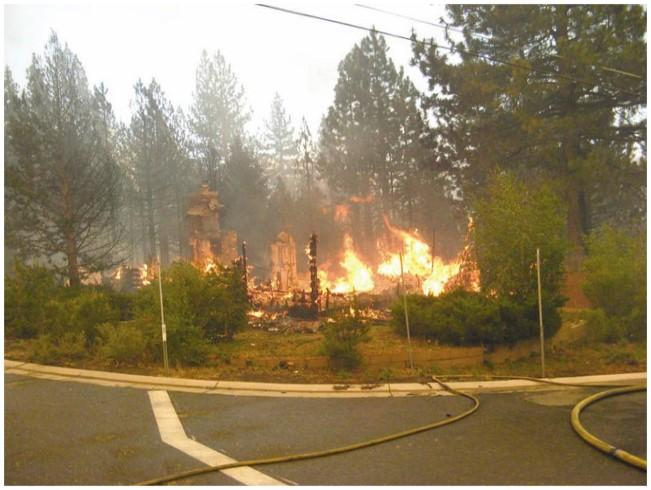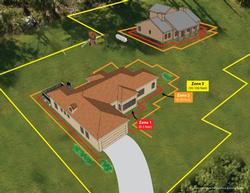Preparing Your Home
Preparing Your Home
Wildfire-Resilient Homes Overview
After a wildfire passes through a community many are left wondering why one home survived and another did not. Whether you are a homeowner, contractor, or renter there is good news - research indicates that wise decisions regarding material choices, design and installation options, and maintenance considerations that can improve the odds that your home will survive a future wildfire. Hardening a home to withstand wildland fire exposure does not have to be costly, but it does require an understanding of the exposures your home will experience when threatened by a wildfire.
How fires spread
Wildland fires spread by a combination of a moving flame front and the wind distribution of burning embers. Embers are small pieces of plants, trees, or buildings that are light enough to be blown through the air and can result in the rapid spread of wildfire by where embers are blown ahead of the main fire, starting new fires.
How homes burn
Home and building loss during wildfires occur as a result of some part of the building igniting from one or more of the three basic wildfire exposures: 1) embers, 2) radiant heat, and 3) direct flame contact.

Embers cause the majority of wildfire home ignition by directly igniting your home or igniting vegetation or materials on or near your home that results in flames touching your house or a high heat (radiant heat) exposure that may break glass in a window. Should embers land on or near your house, they accumulate (like hail) and can easily ignite the plants and mulch near your home, dry leaves, or lawn furniture. They also land on the roof, deck, or porch and depending on the condition of each may find a gap to enter the house or can catch accumulated dry leaves on fire. Very commonly embers enter the home or attic through a vent or open window. When embers enter the home or attic, they can easily ignite the contents of the house and the home will burn seeming from the inside out. When embers enter the house directly there is often little damage to the surrounding vegetation and many are left puzzled as to what caused the home to burn.

What you can do
Homes survive wildfire through a combination of:
1) careful landscape selection, placement, and maintenance
2) awareness and management of combustible materials on the property (e.g. leaf litter or lawn furniture) during your fire season
3) incorporation of fire and ember resistant construction materials, installation details and maintenance.
Use the suggestions below to learn how to harden your home by reducing its vulnerability. Keep in mind that developing wildfire resilience is more than having a metal roof or stucco siding.
Ember-resistant construction relies on awareness of seemingly small details that can make your home vulnerable to embers, in addition to building with appropriate materials, and regular home and property maintenance.
The following table summarizes the vulnerabilities of your home and recommended actions you can take to address them. Each of the components of the home are prioritized to offer some general guidance; however, each situation is unique. If your neighbor’s house is close to you the lower priority items increase in their importance because of the potential that your neighbor’s home can catch on fire and send embers to your house or provide a high and extended radiant heat exposure overwhelming your home.
Priorities
|
Priority |
Function and Wildfire Vulnerability |
Recommendations |
|
#1 Roof
|
Because your roof a large horizontal surface, the roof is arguably the most vulnerable component of your home. The job of the roof is to protect the house from sun, rain, and during fire, from embers. Complex roofs, where the roof meets vertical walls and/or includes dormers present additional vulnerabilities. |
Use materials with a Class A fire rating. Carefully follow the manufacturers installation instructions because some roof coverings need additional protection to meet the Class A requirements. Common Class A fire-rated materials include asphalt composition shingles, tile, and steel. Install with a metal drip edge at the roof edge. Clean out and maintain gutters. Plug gaps between the roof covering and sheathing. Maintain your roof and replace when necessary. |
|
#1 Vents
|
Vents provide two important functions. Vents allow for air circulation to reduce the heat in your attic and allow moisture to escape that can lead to moisture degradation issues over time. Embers can easily slip through foundation, roof, or attic vents. Once inside, embers can ignite debris and items stored inside the house. |
Move combustible items away from vents both inside and outside the house. Replace 1/4” mesh vents with 1/8” mesh or install vents that meet new ember and flame resistant requirements. Regularly check vents and remove materials that may plug vent openings. Prepare temporary plywood vent covers to install prior to the approach of a wildfire, if you have sufficient preparation time. Or consider using metal tape to temporarily seal up vents from the inside of the house. |
|
#1 Vegetation
|
All plants can burn during a wildfire. Placement of landscaping vegetation and combustible mulch immediately around your home, and under windows, eaves, and vents can provide a way for fire to enter the home. Embers can easily be blown across a green lawn and ignite vegetation adjacent to the house. Leaf litter and needles can accumulate in or on rooves, gutters, decks, porches, and next to the house. The same challenges apply to outbuildings, sheds, and detached garages. In addition to your home, vegetation management treatments should also be given to these structures using the same zone approach. |
Home Ignition Zones:
Zone 1. 0-5 feet. This is highest priority zone. Start with the house and work outwards by creating a 5-feet wide noncombustible zone around the entire house (and under the deck) to reduce the potential for an ignition by wind-blown embers. If ignited, these materials will result in a direct flame contact to the house. Use hardscape (pavers or crushed rock), maintained lawn, or low-cut grass. Cut tree branches that overhang the house. Zone 2. 5-30 feet. Lean and green zone. The goal is to reduce the intensity of the fire and potential for ember generation from the landscape. Trees and taller vegetation should be well-maintained separated from the house and each other. Remove vegetation under trees to prevent fire from climbing to the top of the trees. Prune mature trees up to 6-10 feet from the ground. Landscaping in this area should include low growing, open structured, less resinous, higher moisture content plants. Zone 3. 30-100 feet or property line. Reduced fuel zone. The goal is to interrupt the fire and keep flames on the ground. Remove or dispose of tree needles or leaves, remove dead trees, thin out small trees and shrubs creating islands of vegetation, limb and prune mature trees up to 6-10 feet. Thin mature trees so that canopies do not touch. |
|
#2 Decks
|
Decks are vulnerable to fires from embers igniting vegetation or stored materials igniting below the deck or ignition of the top of the deck. Leaves and needles can build up in gaps between deck boards, creating targets for embers to ignite. On top of decks embers can also land wood furniture, door mats, brooms, umbrellas, or plants that are easily ignitable. If the deck ignites, it will provide a flame exposure to either the exterior wall and under-eave area.
|
Clean and maintain the deck by removing debris that can accumulate on the deck and in the between deck board gaps. Do not store combustible materials under the deck. Before evacuating bring combustible door mats, brooms and furniture cushions inside. Move deck furniture off the deck. Move bar-b-que propane tanks away from the house. For new deck installation, when non-fire retardant treated wood is used:
|
|
#3 Windows
|
As a fire approaches, close all windows and skylights to prevent ember entry. The glass is the most vulnerable part of the window. Multi-pane tempered glass is best because it distributes the heat load and provides a second layer of protection if the first pane fails. Larger windows are more vulnerable than smaller windows. For vinyl windows confirm there is a vertical or horizonal reinforcement bar. |
Install or upgrade to multi-pane tempered glass windows. Remove vegetation immediately outside of the windows. When a neighboring home or building is within 30 feet of your home; consider installing noncombustible shutters to close upon evacuation or cover your windows with temporary plywood covers prior to evacuating. |
|
#4 Eaves
|
The eave overhang protects your home from rain and sun. Depending on design, it also can trap heat and allow embers to enter through under-eave attic vents. With open-eave construction gaps between the rafter tails and the blocking can be vulnerable to ember entry. Soffited eaves (boxed-in) are more robust to embers. |
With open-eave construction inspect eaves for gaps around rafter roof tails and blocking. Plug or caulk gaps. If possible, create a soffited eave where an open-eave design exists. Vents should be upgraded to 1/8” metal mesh screening. Remove vegetation and combustible materials below eaves. |
|
#5 Siding
|
Siding is vulnerable if exposed to flames or radiant heat for extended periods. A carefully developed and maintained home ignition zone will minimize the potential for this exposure. Where neighboring homes are within 30 feet of your home, use of a noncombustible or ignition resistant materials would reduce the vulnerability of your home. Gaps and joints in siding can create places where flame penetration can occur. Poorly maintained or degraded siding is also vulnerable to flame penetration. Many homes with stucco, cinder block, or fiber cement siding are lost to wildfire because other design and maintenance considerations have not been followed or have been overlooked, allowing embers to either ignite external materials or penetrate into the building. In general, combustible panels and horizontal siding with more complicated lap joints (e.g., tongue and groove and ship lap) are more resistant to flame penetration into the stud cavity. |
Along with the 5’ noncombustible horizontal zone, maintain a 6” noncombustible vertical zone between the ground (and other horizontal surfaces) and the start of the siding. Inspect all siding and plug or caulk gaps and joints. If a neighbor’s house or an outbuilding is close to the house, a fire-retardant gypsum board can be installed under the siding to increase the fire-resistance of the wall should the siding ignite. Gel coatings are difficult to install and are limited in the number of hours that they provide protection; therefore, they are not recommended. |




